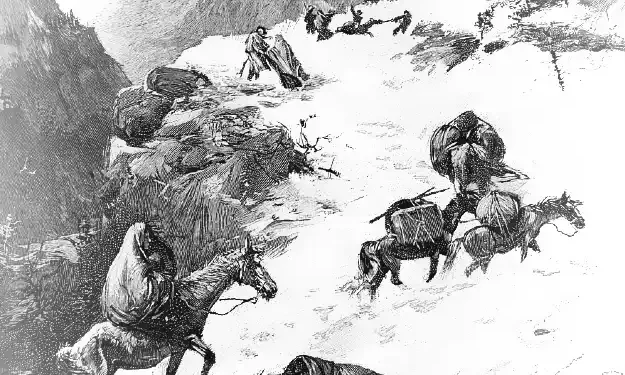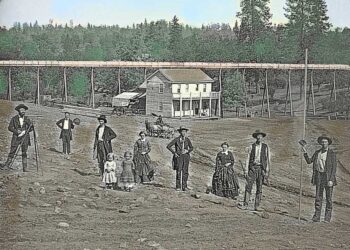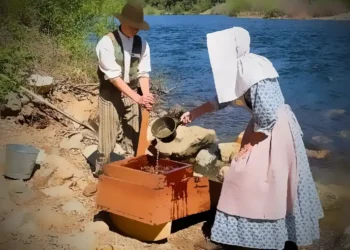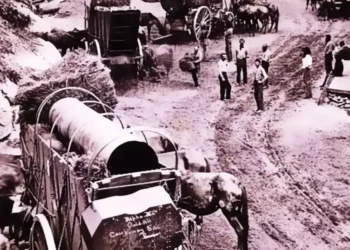Truckee, CA (El Dorado County) — Beneath the serene surface of Donner Lake, nestled in the high Sierra three miles west of modern-day Truckee, lies a story that echoes through California history with chilling gravity. In the fall and winter of 1846-1847, 87 pioneers—drawn by the lure of California’s promise—became prisoners of the snow, victims of bad luck, bad advice, and a merciless winter storm.
The Donner Party, named for brothers George and Jacob Donner and fellow organizer James F. Reed, began its journey in Springfield, Illinois, in April 1846. By May, they had joined a growing caravan of settlers in Independence, Missouri, with families like the Donners, Reeds, Graves, and Murphys comprising the core. Spirits were high. A letter from Tamsen Donner dated June 16 reported favorable travel through the Great Plains, with no hint of the doom ahead.
Trouble began at Fort Bridger in modern-day Wyoming. There, the group took a fateful gamble on the newly promoted Hastings Cutoff—a supposed shortcut through the Wasatch Mountains and the Great Salt Lake Desert. This “shortcut” delayed the group by more than a month and cost them precious time before winter’s onset.
By October 28, 1846, the party was trapped by an early Sierra snowstorm at Prosser Creek. Some 22 feet of snow would eventually bury the trails. Desperate families scattered around Donner Lake and Alder Creek, constructing makeshift cabins and subsisting on rawhide, frozen oxen, and eventually—grimly—human flesh. The most tragic decision was not one of malice but necessity.
On December 16, a desperate group of 17 left camp on snowshoes seeking help. Known later as the “Forlorn Hope,” only seven survived the 32-day march through the mountains. Among them was Mary Graves, who later recalled, “Can anyone imagine what joy those footprints gave us?”
Relief finally arrived on February 19, 1847, led by Captain Reasin P. Tucker and funded by John Sutter of Fort Sutter fame. Over the next two months, four rescue missions struggled through storm and starvation to bring survivors out. Many rescuers, like James F. Reed—who had preceded the party into California—risked their own lives in return.
George Donner, gravely ill, died at Alder Creek. His wife, Tamsen, refused to abandon him. Their final act of love is one of the most haunting in the annals of westward migration. “She retraced the weary distance to die with him whom she had promised to love and honor to the end,” recorded the Thompson & West history.
Of the original 87 members, 42 perished. The final survivor, Lewis Keseberg, was rescued on April 7, 1847. Today, their story is etched not just in stone markers and state parks but in California’s very DNA—a warning, a testament, and a tribute to resilience.
The lessons are timeless. As local historian Claude Chana, a member of a nearby emigrant group who passed through safely just two weeks prior, reflected later: “One storm—just one—made all the difference.”
Sources:
HISTORY OF THE DONNER PARTY. [History of Nevada County, California (1880) by Thompson and West.]
“Three miles from the town of Truckee, and resting in the green lap of the Sierras, lies one of the loveliest sheets of water on the Pacific coast. Tall mountain peaks are reflected in its clear waters, revealing a picture of extreme loveliness and quiet peace. Yet this peaceful scene was the amphitheater of the most tragic event in the annals of early California.
‘The Donner Party’ was organized in Sangamon county, Illinois, by George and Jacob Donner and James F. Reed in the spring of 1846. In April, 1846, the party set out from Springfield, Illinois, and by the first week in May had reached Independence, Missouri, where the party was increased until the train numbered about two or three hundred wagons, the Donner family numbering sixteen, the Reed family seven, the Graves family twelve, the Murphy family thirteen. These were the principal families of the Donner party proper. At Independence provisions were laid in for the trip and the line of journey taken In the occasional glimpses we have of the party, features of but little interest present themselves beyond the ordinary experience of pioneer life. A letter from Mrs. George Donner, written near the junction of the North and South Platte, dated June 16, 1846, reports a favorable journey of four hundred and fifty miles from Independence, Missouri, with no forebodings of the terrible disasters so soon to burst upon them. At Fort Laramie a portion of the party celebrated the Fourth of July. Thereafter the train passed unmolested upon its journey. George Donner was elected captain of the train at the Little Sandy river, on the 20th of July, 1846, from which act it took the name of ‘Donner Party.’
“At Fort Bridger, then a mere trading post, the fatal choice was made of the route that led to such fearful disasters and tragic death. A new route via. Salt Lake, known as ‘Hasting’s Cut-off,’ was recommended to the party as shortening the distance three hundred miles. After due deliberation the Donner party of eighty-seven souls —three having died Cut-off. —were induced to separate from the larger portion of the train (which afterwards arrived in California in safety) aud commenced, their journey by way of Hasting’s They reached Weber river ‘near the head of the canyon in safety. From this point in their journey to Salt Lake, almost insurmountable difficulties were encountered, and instead of reaching Salt Lake in one week, as anticipated, over thirty days of perilous travel were consumed in making the trip —most precious time in view of the danger imminent in the rapidly approaching storms of the winter. The story of their trials and sufferings in their journey to the fatal camp at Donner lake is terrible ; nature and stern necessity seemed arrayed against them.
19th of October, near the present site of Wadsworth, Nevada, the destitute company were happily re-provisioned by C. T. Stanton, furnished with food and mules, together with two Indian vaqueros, by Captain Sutter, without compensation. “At the present site of Reno it was concluded to Three or four days time was lost. This was the fatal act. The storm-clouds were already brewing upon the mountains, only a few miles distant. The ascent was ominous. Thick and thicker grew the clouds, outstripping in threatening battalions the now eager feet of the alarmed emigrants, until, at Prosser creek, three miles below Truckee, October 28, 1846,3 month earlier than usual, the storm set in, and they found themselves in six inches of newly-fallen snow. On the summit it was already from two to five feet deep. The party, in much confusion, finally reached Donner lake in disordered fragments. Frequent and desperate attempts were made to cross the mountain tops, but at last, baffled and despairing, they returned to camp at the lake. The storm now descended in all its pitiless fury upon the ill-fated emigrants. Ls dreadful import was well understood as laden with omens of suffering and death. With slight interruptions the storm continued for several days. The animals were literally buried alive and frozen in the drifts. Meat was hastily prepared from their frozen carcasses, and cabins rudely built. One, the Schallenberger cabin, erected November, 1844, was already standing about a quarter of a mile below the lake. This the Breen family appropriated. The Murphys erected one three hundred yards from the lake, marked by a Large stone twelve feet high. The Graves family built theirs near Donner creek, three-quarters of a mile further down the stream, the three forming the apex of a triangle ; the Breen and Murphy cabins were distant from each other about one hundred and fifty yards.
The Donner brothers, with their families, hastily constructed a brush shed in alder creek valley, six or seven miles from the lake. Their provisions were speedily consumed, and starvation with all its grim attendant horrors stared the poor immigrants in the face. Day by day, with aching hearts and paralyzed energies, they awaited, amid the beating storms of the Sierras, the dread revelation of the morrow, ‘hoping against hope’ for some welcome sign. “On the 16th day of December, 1846, a party of seventeen were enrolled to attempt the hazardous journey over the mountains, to press into the valley for relief Two returned, remaining fifteen, including Mary Graves and her sister, Mrs. Sarah Fosdick, and several other women, pressed on. The heroic C. T. Stanton and noble F. V. Graves (who left his wife and seven children at the lake to await his return) being the leaders. This was the ‘Forlorn Hope Party,’ over whose dreadful sufferings and disaster we must throw a veil. Death in the most awful form reduced the wretched company to seven —two men and five women—when suddenly tracks were discovered imprinted in the snow. ” Can any one imagine,” says Mary Graves in her recital, “what joy these foot prints gave us ?
We ran as fast as our strength would carry us.” Turning a sharp point they suddenly came to an Indian rancheria. The acorn-bread offered them by the kind and awe-stricken savages was eagerly devoured. But on they pressed with their Indian guides only to repeat their dreadful sufferings until at last, one evening about the last of January, Mr. Eddy with his Indian guide, preceding the party fifteen miles reached Johnson’s ranch, on Bear river, the first settlement on the western slope of the Sierras, when relief was sent back as soon as possible, and the remaining six survivors were brought in next day. It had been thirty-two days since they left Donner lake. No tongue could tell, no pen portray, the awful suffering, the terrible and appalling straits, as well as the noble deeds of heroism that characterized this march of death. The eternal mountains, whose granite faces bore witness to their sufferings are fit monuments to mark the last resting-place of Charles T. Stanton, that cultured heroic soul, who groped his way through the blinding snow of the Sierras to immortality.
The divinest encomium
He gave his life as a ransom for many ‘ —is the epitaph, foreshadowed in his own noble words, ‘ I will bring aid to these famishing people or lay down my life.
” Nothing could be done, in the meantime, for the relief of the sufferers at Donner lake, without securing help from Fort Sutter, which was speedily accomplished by John Rhodes. In a week, six men, fully provisioned, with Captain Reasin P. Tucker at their head, reached Johnson’s ranch, and in ten or twelve days” time, with provisions, mules, etc., the first relief party started for the scene at Donner lake. It was a fearful undertaking, but on the morning of the 19th of February, 1847, the above party began the descent of the gorge leading to Donner lake. ” We have purposely thrown a veil over the dreadful sufferings of the stricken band left in their wretched hovels at Donner lake. Reduced to the verge of starvation, many died (including children, seven of whom were nursing babes), who, in this dreadful state of necessity, were summarily disposed of Rawhides, moccasins, strings, etc., were eaten. But relief was now close at hand for the poor, stricken sufferers. On the evening of the 19th of February, 1847, the stillness of death, that had settled upon the scene, was broken by the prolonged shouts. In an instant the painfully sensitive ears of the despairing watchers caught the welcome sound. Captain Tucker, with his relief party, had at last arrived upon the scene. Every face was bathed in tears, and the strongest men of the relief party melted at the appalling sight, sat down, and wept with the rest. But time was precious, as storms were imminent. The return party was quickly gathered. Twenty-three members started, among them several women and children. Of this number two were compelled to return, and three perished on the journey.
Many hardships and privations were experienced, and their provisions were soon entirely exhausted. Death once more stared them in the face, and despair settled upon them. But assistance was near at hand. James F. Reed, who had preceded the Donner party by some months, suddenly appeared with the second relief party, on the 25th of February, 1847. The joy of the meeting was indescribable, especially between the family and the long absent father. Reprovisioned, the party pressed on, and gained their destination after severe suffering, with eighteen members, only three having perished. Reed continued his journey to the cabins at Donner lake. There the scene was simply indescribable ;
starvation and disease were fast claiming their victims. March ist, according to Breen’s diary, Reed and his party reached the camp. Proceeding directly to his cabin, he was espied by his little daughter, who, with her sister, was carried back by the previous party, and immediately recognized with a cry of joy. Provisions were carefully dealt out to the famishing people, and immediate steps were taken for the return. Seventeen composed this party. Half starved and completely exhausted, they were compelled to camp in the midst of a furious storm, in which Mr. Reed barely escaped with his life. This was ‘ Starved Camp,’ and from this point Mr. Reed, with his two little children and another person, struggled ahead to obtain hasty relief, if possible. ” On the second day after leaving ‘ Starved Camp,’ Mr. Reed and the three companions were overtaken by Cady and Stone, and on the night of the third day reached Woodworth’s camp, at Bear valley, in safety. The horrors of Starved Camp beggar all description, indeed, require none. The third relief party, composed of John Stark, Howard Oakley, and Charles Stone, were nearing the rescue, while W. H. Foster and W. H. Eddy (rescued by a former party) were bent on the same mission. These, with Hiram Miller, set out from Woodworth’s camp on the following morning after Reed’s arrival. The eleven were duly reached, but were in a starving condition, and nine of the eleven were unable to walk. By the noble resolution and herculean efforts of John Stark, a part of the number were borne and urged onward to their destination, while the other portion was compelled to remain and await another relief party. When the third relief party, under Foster and Eddy, arrived at Donner lake, the sole survivors of Alder creek were George Donner, the captain of the company, and his heroic and faithful wife, whose devotion to her dying husband caused her own death, during the last and fearful days of waiting for the fourth relief. George Donner knew he was {iying, and ureed his wife to save her life and go with her little ones with the third relief, but she refused. 59 and How it Happened—Communication of the Discovery to Sutter Nothing was more heart-rending than her sad parting with her beloved little ones, who wound their childish arms lovingly around her neck, and besought her with mingled tears and kisses to join them. But duty prevailed over affection, and she retraced the weary distance to die with him whom she had promised to love and honor to the end. Such scenes of anguish are seldom witnessed on the sorrowing earth, and such acts of triumphant devotion are among the most golden deeds. The snowy cerements of Donner lake enshrouded in its stilly whiteness no purer life, no purer heart than Mrs. George Donner’s. The terrible recitals that close this awful tragedy we willingly omit. ” The third relief party rescued four of the last five the fourth and last- relief party rescued the survivors ; party. last survivor, Lewis Keseberg, on the 7th of April.
Ninety names are given as members of the Donner Of these forty-two perished, six did not live to reach the mountains, and forty-eight survived. Twenty-six, and possibly twenty-eight, out of the forty-eight survivors are living today —several of them residing in San Jose, Calistoga, Los (iatos, Marysville, and in Oregon. “Thus ends this narrative of horrors, without a parallel in the annals of American history, of appalling disaster, fearful sufferings, heroic fortitude, self-denial and heroism.”
About two weeks before the Donner party found the way across the mountains barred with snow, another emigrant train passed in safety ; among these emigrants were Claude Chana, now living at Wheatland, Yuba county, and Charles Covillaud, one of the original proprietors of Marysville, who married Mary Murphy, of the Donner party, from whom the name of Marysville was derived. The widely different ex])eriences of those two parties, in crossing the Sierras over the same mountain route, gives a striking illustration of the sudden changes that, inside of a few days, by means of one single storm, may appear in this region, and that traveling in, or over the mountains in the winter season, under any consideration, is a venturesome enterprise.









